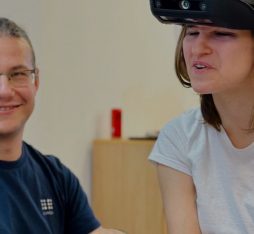● Its director and co-founder, Hugo Dinh, is convinced that digital diagnostics will respond to a need to make life easier for doctors and optimise the quality of medical data.
● Just as Apple Watch has done with its continuous measurement of cardiac activity, easy-to-use mobile and connected devices should, in the mid- to long-term, facilitate the detection of early signs of complex diseases like Alzheimer’s.
Why is there booming investment in digital diagnostic tools?
Before the health crisis, doctors relied on traditional diagnostic tools. However, Covid19 highlighted that even in our era of advanced medical equipment, digital diagnostic tools have a major role to play, especially when hospitals are overcrowded. This awakening has also been accelerated by companies like Apple, who have pioneered innovation by integrating health sensors in their watches. Now with assistance from artificial intelligence, we can confidently say that we are only at the beginning of digital diagnostics. For virtually all diseases, early diagnosis is synonymous with optimal treatment. This is notably the case with Alzheimer’s. Along with that, we can look at examples of people with heart diseases like arrythmia and tachycardia: in cases where they are always wearing Apple Watches, they can count on the constant transmission of relevant information to cardiologists, which is much better than data collected over just a few days.
Can you tell us a little about the diagnostic tool you have designed?
At NaoX Technologies, our focus is on epilepsy: a disease that affects 600,000 people in France and more than 50 million worldwide. Patients who need an can expect to wait for six months to a year, and neurologists are rare resources. Our medical device, which is entirely portable and looks and feels like a regular pair of earbuds, responds to a need for doctors to conduct diagnostic tests outside of hospitals and within relevant timeframes. Our earbuds transmit data to wearers’ smartphones, which is thereafter relayed to their doctors. At the same time, our users can also opt to share their data with the research community. Today, we are focusing on the relationship between doctors and patients, which is an overarching priority and also a sensitive issue when it involves the sharing of health data.
We needed a solution that enabled us to conduct diagnostic tests on an everyday basis, which also made the measurement of brain activity more accessible in Europe.
How did you develop your solution?
We started out in 2015 when I was working on statistical approaches to epilepsy with my former professor, Michel Le Van Quyen, who is now business my partner. We were studying electrical signals in the brain that we entered into mathematical models to see if particular patients had warning signs of impending epileptic seizure, using what we would now call an artificial intelligence approach. Back then, and even still today, the only way to obtain basic data was with an EEG, which had to be conducted in a hospital or clinic. At the time, we also learned that the algorithm to detect neurological disease needed to be fed with continuous streams of data, and that occasional tests were not adequate for this purpose. What we needed was a solution that could make diagnostic testing a part of everyday life, which would also democratize access to the measurement of brain activity.
Why did you decide to make a medical device in the form of earphones?
We met with teams that made devices in the form of headbands for the same use. However, the signal quality they obtained was not sufficient, and nobody wanted to wear devices of that kind on a day-to-day basis. When Apple brought out their AirPods in 2017, they opened up an immense market, and, at the same time, we realized that the ear canal was a good place from which to monitor brain activity. That is when we created our buds. They disguised a medical device as earphones, as a fashion accessory that everyone knows how to use.
What is your roadmap?
We want to release a product that is robust enough for medical use. It needs to comply with standards and also to be certified. This approval process takes time, which is why we are not planning to launch our offer of services until 2024. We also want to ensure that the use of our device will be covered by health insurance. Because we are not selling a product per se, but an offer of services that includes the device, data collection and processing, and medical consultation. We would like to offer all of this this at a price close to what patients now pay for an EEG procedure, which ranges from 80 to 250 euros.
Read more :
La Medtech, futur de la santé (podcast, French)
An EEG is a medical procedure that measures electrical activity in the brain using electrodes which are usually placed on the scalp.












